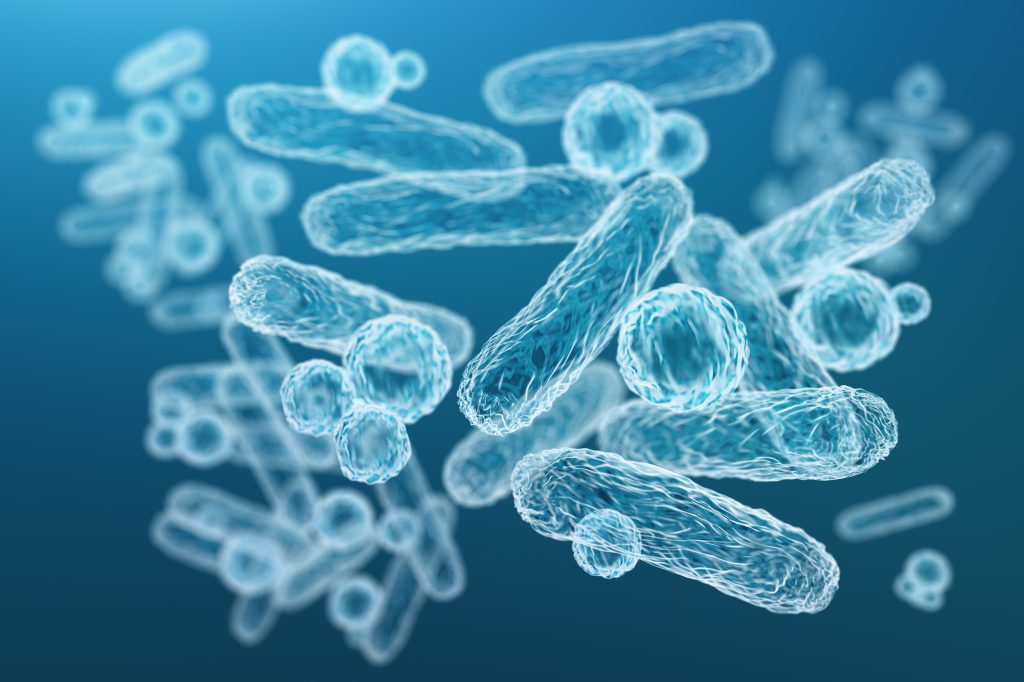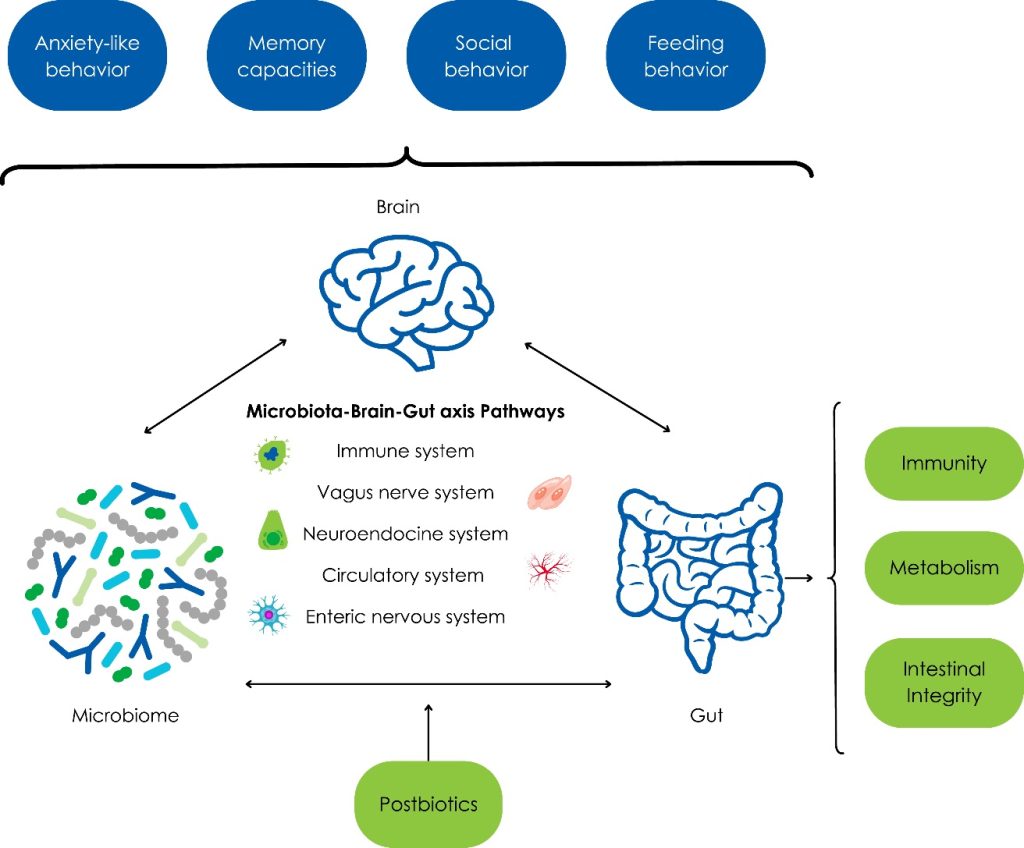
Postbiotics unveiled: a new era in enhancing animal well- being and production
Postbiotics: advancing animal health and performance
Postbiotics, the preparation of bioactive compounds produced during the fermentation process by beneficial microorganisms, and sometimes, the dead microorganisms themselves, offer a cutting-edge approach to animal health and production. By leveraging the power of these metabolites, we can enhance gut function, boost immunity, and improve overall well-being in production animals and
pets.
The transition to postbiotics marks an exciting advancement in animal nutrition, harnessing the power of microbial metabolites to improve animal health and performance. These metabolites retain the beneficial properties of probiotics but offer unique characteristics, such as stability, ease of application, and standardized composition (1, 2, 3, 4, 5, 6). These microbial metabolites can include:
Enzymes, biological catalysts that can improve digestibility and feed efficiency by breaking down complex nutrients, such as carbohydrates, proteins, and fats, into simpler forms that animals can absorb and use more efficiently. By improving nutrient digestibility, enzymes contribute to better feed efficiency, reduce feed costs, and minimize nutrient waste. They are particularly beneficial for animals that have
difficulty digesting certain feed ingredients (1, 4, 7, 8).
Antioxidants, play a crucial role in protecting animals against oxidative stress. Reactive oxygen species (ROS) can damage cells and tissues, causing inflammation, impaired immune function, and reduced performance, particularly during stress or high metabolic demands. Metabolites with antioxidant activity include enzymes, such as catalase (CAT), glutathione peroxidase, and superoxide dismutase, and compounds such as carotenes, flavonoids, coenzyme Q, and vitamin C (8, 9, 10).
Organic acids offer multiple benefits, including supporting intestinal health and controlling pathogens. These acids support gastrointestinal pH to restrict the growth of harmful bacteria, such as Salmonella and E. coli, reducing the risk of gastrointestinal infections and promoting a balanced and healthy intestinal ecosystem (8, 11). They also provide energy for other bacteria in the gut microbiota and epithelial cells of the gastrointestinal tract.
The benefits of postbiotics in animal health
Postbiotics exert their beneficial effects on animal health through various mechanisms of action. They can directly inhibit the growth of pathogenic bacteria by producing antimicrobial substances, creating a hostile environment for harmful microorganisms. Postbiotics can modulate the immune system, improving immune responses and reducing the risk of infections and inflammatory diseases. They also contribute to intestinal health by promoting the growth of beneficial bacteria and supporting the gut microbiota, improving nutrient absorption, and strengthening intestinal barrier function. Additionally, postbiotics have been shown to have antioxidant properties, supporting the overall health and well-being of animals (1, 2,3, 5, 12, 13, 14, 15).
Postbiotics, via their diverse mode of action and direct influence on the gut microbiota, have a key role to play in keeping the microbiota-gut-brain axis (MGBA) in balance (16). The MGBA is a system of bidirectional communication between the central nervous system, peripheral nervous system and intestinal function (Figure 1). There are also similar systems connecting the gut microbiota and the lungs, liver and reproductive organs for example (17). The MGBA influences the majority physiological and psychological functions and is an essential component of animal resilience (18).

The advantages of postbiotics
Postbiotics offer several advantages over traditional feed additives. Unlike live microorganisms, postbiotics are thermostable, do not require refrigeration or special handling, and have a longer shelf life. They can withstand processing conditions, making them more suitable for pelleted or extruded feed formulations (2, 19, 20, 21).
These advantages make postbiotics a promising alternative to traditional feed additives, providing a safe, effective, and practical solution to improve animal health and performance (5, 20).
Innovation and regional regulations: shaping the use of postbiotics in animal production
Embracing innovation in animal nutrition is essential to building a sustainable future in livestock farming. With increasing global demand for animal products, it is crucial to explore and adopt new technologies, strategies, and feed additives that can improve animal health, performance, and environmental sustainability. By staying informed about scientific advances and incorporating them into production systems, stakeholders in the livestock industry can play an important role in creating a sustainable and resilient future. Through these efforts, we can ensure animal well-being, meet the demands of a growing population, and promote a healthier planet for future generations (1, 5, 11, 12, 14, 17, 21).
References
1) Liang B, Xing D. The current and future perspectives of postbiotics. Probiotics Antimicrob Proteins. 2023,15(6):1626-1643. doi: 10.1007/s12602-023-10045-x.
2) Zhong Y, Wang S, Di H, Deng Z, Liu J, Wang H. Gut health benefit and application of postbiotics in animal production. J Anim Sci Biotechnol. 2022, 13(1):38. doi: 10.1186/s40104-022-00688-1.
3) Alameri F, Tarique M, Osaili T, Obaid R, Abdalla A, Masad R, Al-Sbiei A, Fernandez-Cabezudo M, Liu SQ, Al-Ramadi B, Ayyash M. Lactic acid bacteria isolated from fresh vegetable products: potential probiotic and postbiotic characteristics including immunomodulatory effects. Microorganisms. 2022, 10(2):389. doi: 10.3390/microorganisms10020389.
4) Velázquez-De Lucio BS, Hernández-Domínguez EM, Villa-Garcia M, Diaz-Godinez G, Mandujano-Gonzalez V, Mendoza-Mendoza B, Alvarez-Cervantes J. Exogenous enzymes as zootechnical additives in animal feed: a review. Catalysts. 2021, 11(7):851. doi:10.3390/catal11070851.
5) Ji J, Jin W, Liu SJ, Jiao Z, Li X. Probiotics, prebiotics, and postbiotics in health and disease. MedComm. 2020, 4(6): e420. doi: 10.1002/mco2.420.
6) Vinderola G, Sanders ME, Salminen S. The concept of postbiotics. Foods. 2022, 8;11(8):1077. doi: 10.3390/foods11081077.
7) Zampiga M, Calini F, Sirri F. Importance of feed efficiency for sustainable intensification of chicken meat production: implications and role for amino acids, feed enzymes and organic trace minerals. World’s Poultry Science Journal. 2021, 77(3):639-659. doi: 10.1080/00439339.2021.1959277.
8) Pandey AK, Kumar O, Saxena MJ. Feed additives in animal health. Nutraceuticals in veterinary medicine. 2019:345-362. doi: 10.1007/978-3-030-04624-8_23.
9) Manuelian CL, Pitino R, Simoni M, Mavrommatis A, De Marchi M, Righi F, Tsiplakou E. Plant feed additives as natural alternatives to the use of synthetic antioxidant vitamins on livestock mammals’ performances, health, and oxidative status: a review of the literature in the last 20 years. Antioxidants. 2021, 10, 1461. doi: 10.3390/antiox10091461.
10) Righi F, Pitino R, Manuelian CL, Simoni M, Quarantelli A, De Marchi M, Tsiplakou E. Plant feed additives as natural alternatives to the use of synthetic antioxidant vitamins on poultry performances, health, and oxidative status: a review of the literature in the last 20 years. Antioxidants. 2021; 10(5):659. doi: 10.3390/antiox10050659.
11) Tugnoli B, Giovagnoni G, Piva A, Grilli E. From acidifiers to intestinal health enhancers: How organic acids can improve growth efficiency of pigs. Animals. 2020, 10(1), 134. doi: 10.3390/ani10010134.
12) Tarique M, Abdalla A, Masad R, Al-Sbiei A, Kizhakkayil J, Osaili T, Olaimat A, Liu SQ, Fernandez-Cabezudo M, al-Ramadi B, Ayyash M, Potential probiotics and postbiotic characteristics including immunomodulatory effects of lactic acid bacteria isolated from traditional yogurt-like products. LWT. 2022. 159: 113207. doi: 10.1016/j.lwt.2022.113207.
13) Fesseha H, Yilma T, Mekonnen E. Postbiotics and their role in healthy life. Journal of Life Science and Biomedicine. 2022, 12(4):64-76. doi: 0.54203/jlsb.2022.8.
14) Vinderola G, Sanders ME, Salminen S, Szajewska H: Postbiotics: The concept and their use in healthy populations. Front. Nutr. 9:1002213. doi: 10.3389/fnut.2022.1002213.
15) Salminen S, Collado MC, Endo A, Hill C, Lebeer S, Quigley EMM, Sanders ME, Shamir R, Swann JR, Szajewska H, Vinderola G. The International Scientific Association of Probiotics and Prebiotics (ISAPP) consensus statement on the definition and scope of postbiotics. Nat Rev Gastroenterol Hepatol. 2021,18(9):649-667. doi: 10.1038/s41575-021-00440-6.
16) Yuan C, He Y, Xie K, Feng L, Gao S, Cai L. Review of microbiota gut brain axis and innate immunity in inflammatory and infective diseases. Front. cell. infect. microbiol. 2023,13: 1282431. doi: 10.3389/fcimb.2023.1282431.
17) Chakraborty P, Majumder P, Banerjee D, Sarkar J. Gut microbiota nexus: Exploring the interactions with the brain, heart, lungs, and skin axes and their effects on health. Med. Microecol. 2024: 100104. doi.org/10.1016/j.medmic.2024.100104.
18) Kraimi N, Dawkins M, Gebhardt-Henrich SG, Velge P, Rychlik I, Volf J, Creach P, Smith A, Colles F, Leterrier C. Influence of the microbiota-gut-brain axis on behavior and welfare in farm animals: A review. Physiol. Behav. 2019, 210: 112658. doi.org/10.1016/j.physbeh.2019.112658.
19) Zhao X, Liu S, Li S, Jiang W, Wang J, Xiao J, Chen T, Ma J, Khan MZ, Wang W, Li M, Li S, Cao Z. Unlocking the power of postbiotics: A revolutionary approach to nutrition for humans and animals. Cell Metab. 2024, 36(4):725-744. doi: 10.1016/j.cmet.2024.03.004.
20) Żółkiewicz J, Marzec A, Ruszczyński M, Feleszko W. Postbiotics-a step beyond pre- and probiotics. Nutrients. 2020, 12(8):2189. doi: 10.3390/nu12082189.
21) Collado MC, Vinderola G, Salminen S. Postbiotics: facts and open questions. A position paper on the need for a consensus definition. Benef. Microbes. 2019, 10(7):711-719. doi: 10.3920/BM2019.0015.
